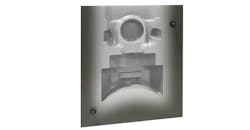Everyone knows that efficiency is a driving factor in metalcasting: Getting the most value out of tooling is a great place to start. Using better techniques, better tooling, and better protective coatings will result in better production costs and fewer headaches for operators and maintenance technicians everywhere.
Many foundries are working with coating technologies to achieve these goals. Using proprietary processes, coatings have been demonstrated to increase overall wear life and production rates. Each coating formulation has benefits and drawbacks, so it is very important to find what works best for your practices.
The base material to which the coating is applied is critical to its successful effect. Having the right combination of machinability and tensile strength can be difficult to determine. Most coatings only affect surface hardness and are not a replacement for heat treating. If the tooling base material has a tendency to move under high pressure, then expect it to move even with a protective coating.
The same concept goes for corrosion resistance. Rust starts within the pores of the metal and works its way to the surface. If steel is prone to rusting, then it will still be susceptible to rust with a coating. A coating might delay rust development, but eventually it will work its way through. Certain coatings that do not have any micro-cracks, like Thin Dense Chrome (TDC), can slow corrosion, but it cannot prevent it completely.
Friction reduction is another effect that can be achieved via coating. A coating that has the ability to reduce the coefficient of friction has some important benefits. Reduced friction helps promote longer wear life; operators do not have to fight the mold as much to release the product. Having parts release from the mold with greater ease is how this is achievable. Use of mold-release agents can be reduced significantly too, and sometimes even eliminated completely from the equation.
A high-production mold being out of production for repair is very costly. The coating industry is a service sector, and finding a company that will work with you is important. Fast turnaround times with high acceptance ratings should be a standard. Once the coating is applied, and after a preventive maintenance program is developed, downtime should be reduced or even eliminated. Not only do molded parts release with greater ease but you should find the same concepts with cleaning the molds as well.
Standard tooling maintenance should be reduced, whether that is weekly, bi-weekly, or even a monthly process. Preventative maintenance programs can be established to avoid costly and time-consuming repairs.
Comparable in importance to tooling base materials, pre- and post-molding operations play a factor, too. Some coatings will reflect the surface finish while others will not. Coatings that tend to be >0.001 in. thick usually need to be refinished to specifications, while thinner coatings will be the last operation before production.
The same goes for the temperature at which the coating is applied. If the coating is a hot temperature process it can create distortion within tool. A cold process coating does not have these challenges.
Choosing the right base material for your coating process is the starting point. Most coatings can be applied to almost all tool steels and alloys. Being able to apply coatings to prototype molds made from P20 or production runners like H13, coated molds will help alleviate problems. Not being able to trial a new design or halt production is money down the drain. Coatings like thin, dense chrome help to make sure that these things do not happen.
Chris Neeley is the sales manager for Armoloy of Ohio. Contact him at LinkedIn or visit www.armoloyofohio.com
